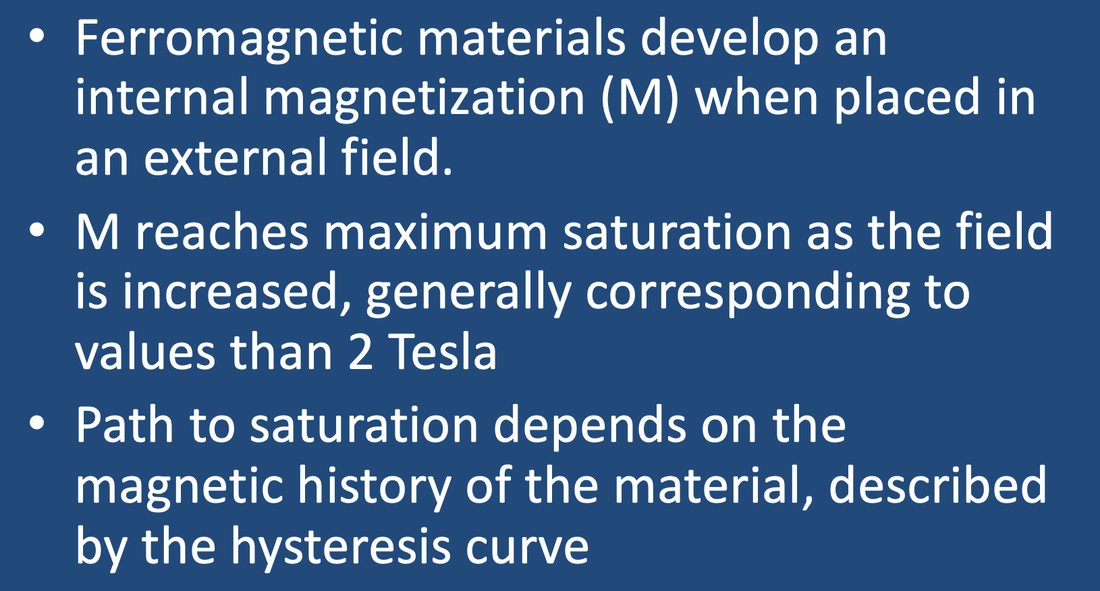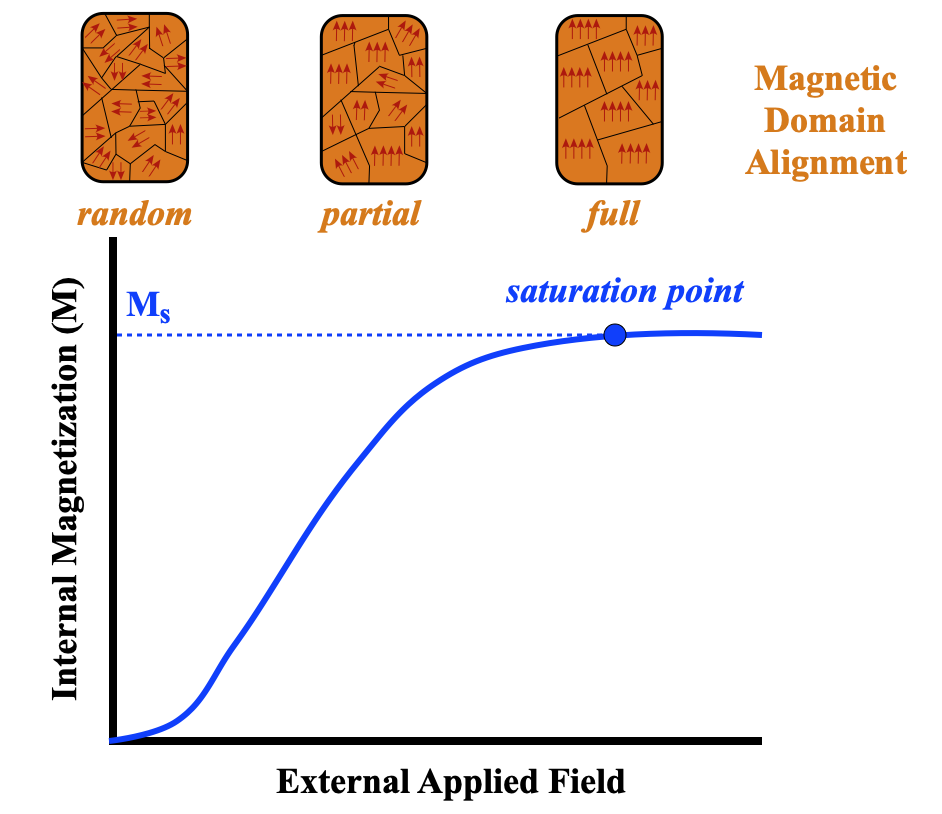When a ferromagnetic material is brought into the presence of a strong external magnetic field, its electron spins in magnetic domains (initially randomly distributed) will begin to align with the field. The domains redefine their walls and grow or shrink to minimize total system energy. As this occurs, the metal develops an internal magnetization (M) that increases until it reaches the saturation point (where all domains are fully aligned). Increasing the external field further has no substantial effect on the material's magnetization.
The table below shows the magnetic saturation values for various ferromagnetic metals and alloys. Thus, for example, even when placed in a 7 T external magnetic field, the maximum internal magnetization of an object made of 410 stainless steel can never exceed a value corresponding to 1.3T.
Surprisingly, the strength of the external magnetic field needed to saturate a ferromagnetic object is not necessarily the same as these magnetic saturation values. The example shown above represents a "virgin" ferromagnetic material (i.e. one that has never been exposed to a strong magnetic field). The past-magnetic history of the object must be taken into consideration before being able to calculate how it will be affected by a newly applied magnetic field. Additionally, the shape and alignment of the object plays a critical role as well, allowing magnetic saturation to occur at external field levels significantly lower than expected.
Magnetic History
 Hysteresis curve for a soft ferromagnetic material. Remanence is the residual magnetization after the external field has been removed. Coercivity is the amount of field reversal needed to bring the internal magnetization back to zero. Dotted path represents the initial magnetization from the metal's virgin state.
Hysteresis curve for a soft ferromagnetic material. Remanence is the residual magnetization after the external field has been removed. Coercivity is the amount of field reversal needed to bring the internal magnetization back to zero. Dotted path represents the initial magnetization from the metal's virgin state.
When a ferromagnetic object is removed from the external applied field (i.e., taken out of the scanner), it will in general not fully return to its previous unmagnetized state but retain some residual magnetization (known as remanence). Hard ferromagnetic materials, such as cobalt steel, nickel, and few alloys of cobalt and aluminum, retain appreciable magnetization and are difficult to demagnetize. By contrast, soft ferromagnetic materials, such as cast iron, silicon steel, and nickel-iron alloys (Permalloy, MuMetal), retain only mild residual magnetism and can be easily demagnetized by applying an external field in the opposite direction, the magnitude of which is known as coercivity.
The actual ramp up path to full saturation therefore depends on the magnetic history of the metal. Ferromagnetic materials exhibit a so-called hysteresis curve after their initial magnetic field exposure. The hysteresis curve is wide for hard ferromagnetic materials but relatively narrow for soft ferromagnetic materials.
The actual ramp up path to full saturation therefore depends on the magnetic history of the metal. Ferromagnetic materials exhibit a so-called hysteresis curve after their initial magnetic field exposure. The hysteresis curve is wide for hard ferromagnetic materials but relatively narrow for soft ferromagnetic materials.
Effect of Object Shape
The object's shape has a fascinating and unexpected effect on its magnetization due to the presence of internal demagnetizing fields. This is a complex topic, discussed more completely in the next Q&A.
Advanced Discussion (show/hide)»
A note on units
I have purposely been a little sloppy in discussing the applied field (H) and internal magnetization (M), referring to values "corresponding to Tesla". Technically both entities are magnetic field intensities, measured in amps/meter rather than Tesla.
References
Food and Drug Administration. Safe Medical Devices Act (SMDA). Section on: orthopedic, prosthetic, and surgical appliances and supplies. Rockville, MD: National Press Office; 1990. (SIC 3842)
Hermawan H, Ramdan D, Djuansjah JRP. Metals for biomedical applications. In: Fazel R (ed). Biomedical Engineering - From Theory to Applications, Intechopen.com, 2011: 411-430. [DOI Link]
Jackson DP. Dancing paperclips and the geometric influence on magnetization: a surprising result. Am J Phys 2006; 74:272-279. [DOI Link]
"Magnetic Susceptibility." Wikipedia, The Free Encyclopedia.
Schenck JF. Safety of strong, static magnetic fields. J Magn Reson Imaging 2000; 12:2-19. [DOI Link]
Schenck JF. The role of magnetic susceptibility in magnetic resonance imaging: MRI magnetic compatibility of the first and second kinds. Med Phys 1996;23:815-850. (Slightly dated, but an excellent and enduring explanation of susceptibility from a pioneer in MRI and first inductee in GE's Genius Hall of Fame). [DOI Link]
Sgobba S. Physics and measurements of magnetic materials. CERN-2010-004: 39-63. [LINK]
Sung HWF, Rudowicz C. Physics behind the magnetic hysteresis loop — a survey of misconceptions in magnetism literature. J Magnetism Magnetic Materials 2003; 260:250-260.
Food and Drug Administration. Safe Medical Devices Act (SMDA). Section on: orthopedic, prosthetic, and surgical appliances and supplies. Rockville, MD: National Press Office; 1990. (SIC 3842)
Hermawan H, Ramdan D, Djuansjah JRP. Metals for biomedical applications. In: Fazel R (ed). Biomedical Engineering - From Theory to Applications, Intechopen.com, 2011: 411-430. [DOI Link]
Jackson DP. Dancing paperclips and the geometric influence on magnetization: a surprising result. Am J Phys 2006; 74:272-279. [DOI Link]
"Magnetic Susceptibility." Wikipedia, The Free Encyclopedia.
Schenck JF. Safety of strong, static magnetic fields. J Magn Reson Imaging 2000; 12:2-19. [DOI Link]
Schenck JF. The role of magnetic susceptibility in magnetic resonance imaging: MRI magnetic compatibility of the first and second kinds. Med Phys 1996;23:815-850. (Slightly dated, but an excellent and enduring explanation of susceptibility from a pioneer in MRI and first inductee in GE's Genius Hall of Fame). [DOI Link]
Sgobba S. Physics and measurements of magnetic materials. CERN-2010-004: 39-63. [LINK]
Sung HWF, Rudowicz C. Physics behind the magnetic hysteresis loop — a survey of misconceptions in magnetism literature. J Magnetism Magnetic Materials 2003; 260:250-260.
Related Questions
What is magnetic susceptibility?
What is ferromagnetism?
I don't understand how an object's shape affects its magnetization.
What is magnetic susceptibility?
What is ferromagnetism?
I don't understand how an object's shape affects its magnetization.


